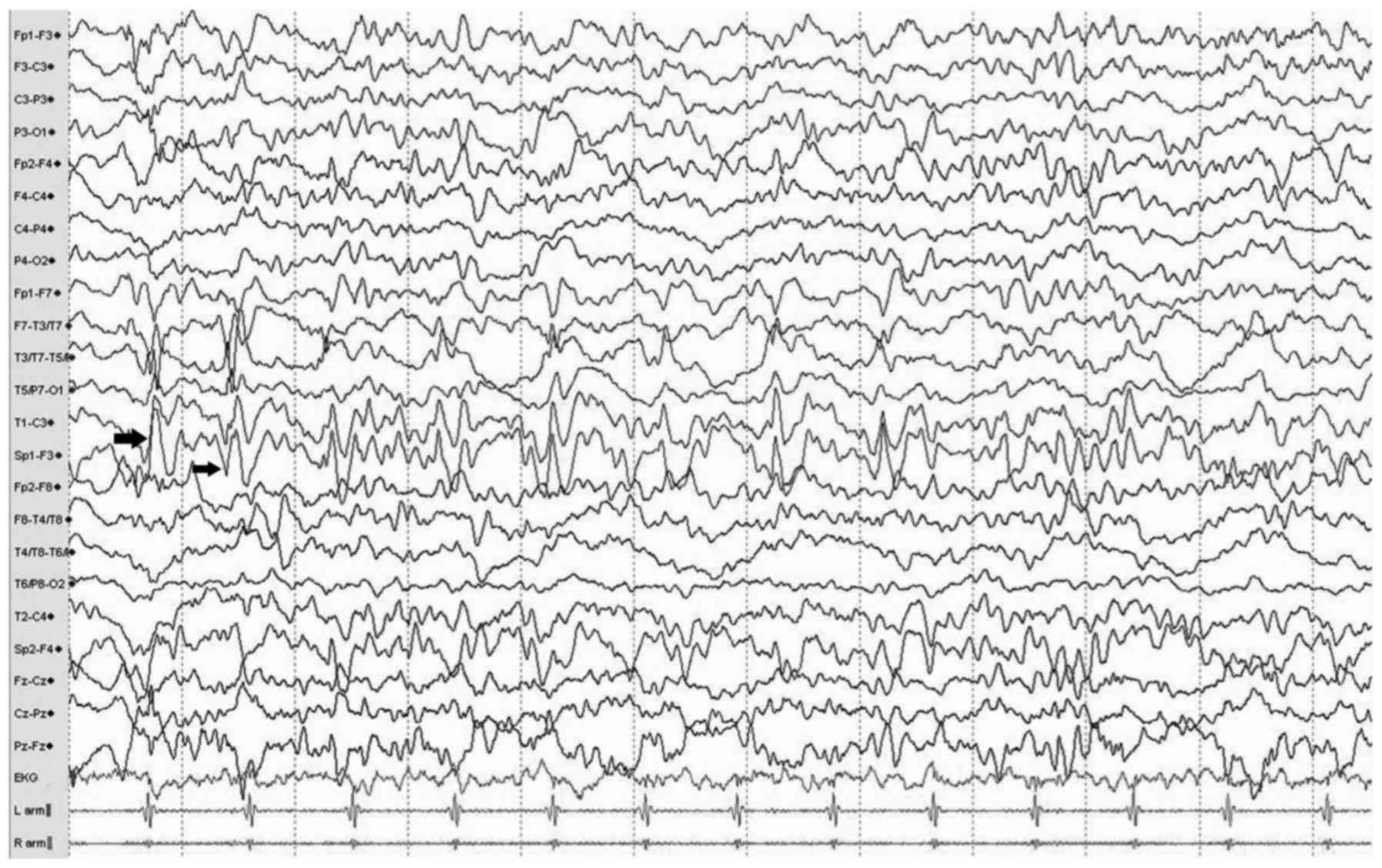|
1
|
Stafstrom CE and Carmant L: Seizures and
epilepsy: An overview for neuroscientists. Cold Spring Harb
Perspect Med. 5:a0224262015. View Article : Google Scholar : PubMed/NCBI
|
|
2
|
Wiebe S, Blume WT, Girvin JP and Eliasziw
M: Effectiveness and Efficiency of Surgery for Temporal Lobe
Epilepsy Study Group: A randomized, controlled trial of surgery for
temporal-lobe epilepsy. N Engl J Med. 345:311–318. 2001. View Article : Google Scholar : PubMed/NCBI
|
|
3
|
Harroud A, Bouthillier A, Weil AG and
Nguyen DK: Temporal lobe epilepsy surgery failures: A review.
Epilepsy Res Treat. 2012:2016512012.PubMed/NCBI
|
|
4
|
Engel J Jr, Wiebe S, French J, Sperling M,
Williamson P, Spencer D, Gumnit R, Zahn C, Westbrook E and Enos B;
Quality Standards Subcommittee of the American Academy of
Neurology; American EpilepsySociety; American Association of
Neurological Surgeons, . Practice parameter: Temporal lobe and
localized neocortical resections for epilepsy: Report of the
quality standards subcommittee of the american academy of
neurology, in association with the american epilepsy society and
the american association of neurological surgeons. Neurology.
60:538–547. 2003. View Article : Google Scholar : PubMed/NCBI
|
|
5
|
Cendes F, Cook MJ, Watson C, Andermann F,
Fish DR, Shorvon SD, Bergin P, Free S, Dubeau F and Arnold DL:
Frequency and characteristics of dual pathology in patients with
lesional epilepsy. Neurology. 45:2058–2064. 1995. View Article : Google Scholar : PubMed/NCBI
|
|
6
|
Salanova V, Markand O and Worth R:
Temporal lobe epilepsy: Analysis of patients with dual pathology.
Acta Neurol Scand. 109:126–131. 2004. View Article : Google Scholar : PubMed/NCBI
|
|
7
|
Jung R, Aull-Watschinger S, Moser D, Czech
T, Baumgartner C, Bonelli-Nauer S and Pataraia E: Is reoperation an
option for patients with temporal lobe epilepsy after failure of
surgery? Seizure. 22:502–506. 2013. View Article : Google Scholar : PubMed/NCBI
|
|
8
|
Mathon B, Bielle F, Samson S, Plaisant O,
Dupont S, Bertrand A, Miles R, Nguyen-Michel VH, Lambrecq V,
Calderon-Garcidueñas AL, et al: Predictive factors of long-term
outcomes of surgery for mesial temporal lobe epilepsy associated
with hippocampal sclerosis. Epelepsia. 58:1473–1485. 2017.
View Article : Google Scholar
|
|
9
|
Engel J Jr: Update on surgical treatment
of the epilepsies. Clin Exp Neurol. 29:32–48. 1992.PubMed/NCBI
|
|
10
|
Tellez-Zenteno JF, Dhar R and Wiebe S:
Long-term seizure outcomes following epilepsy surgery: A systematic
review and meta-analysis. Brain. 128:1188–1198. 2005. View Article : Google Scholar : PubMed/NCBI
|
|
11
|
Tonini C, Beghi E, Berg AT, Bogliun G,
Giordano L, Newton RW, Tetto A, Vitelli E, Vitezic D and Wiebe S:
Predictors of epilepsy surgery outcome: A meta-analysis. Epilepsy
Res. 62:75–87. 2004. View Article : Google Scholar : PubMed/NCBI
|
|
12
|
Spencer S and Huh L: Outcomes of epilepsy
surgery in adults and children. Lancet Neurol. 7:525–537. 2008.
View Article : Google Scholar : PubMed/NCBI
|
|
13
|
Radhakrishnan K, So EL, Silbert PL, Jack
CR Jr, Cascino GD, Sharbrough FW and O'Brien PC: Predictors of
outcome of anterior temporal lobectomy for intractable epilepsy: A
multivariate study. Neurology. 51:465–471. 1998. View Article : Google Scholar : PubMed/NCBI
|
|
14
|
Jeong SW, Lee SK, Hong KS, Kim KK, Chung
CK and Kim H: Prognostic factors for the surgery for mesial
temporal lobe epilepsy: Longitudinal analysis. Epilepsia.
46:1273–1279. 2005. View Article : Google Scholar : PubMed/NCBI
|
|
15
|
Bocti C, Robitaille Y, Diadori P, Lortie
A, Mercier C, Bouthillier A and Carmant L: The pathological basis
of temporal lobe epilepsy in childhood. Neurology. 60:191–195.
2003. View Article : Google Scholar : PubMed/NCBI
|
|
16
|
Kelemen A, Barsi P, Eross L, Vajda J,
Czirjak S, Borbely C, Rasonyi G and Halasz P: Long-term outcome
after temporal lobe surgery-prediction of late worsening of seizure
control. Seizure. 15:49–55. 2006. View Article : Google Scholar : PubMed/NCBI
|
|
17
|
Louis DN, Perry A, Reifenberger G, von
Deimling A, Figarella-Branger D, Cavenee WK, Ohgaki H, Wiestler OD,
Kleihues P and Ellison DW: The 2016 world health organization
classification of tumors of the central nervous system: A summary.
Acta Neuropathol. 131:803–820. 2016. View Article : Google Scholar : PubMed/NCBI
|
|
18
|
Palmini A, Najm I, Avanzini G, Babb T,
Guerrini R, Foldvary-Schaefer N, Jackson G, Luders HO, Prayson R,
Spreafico R and Vinters HV: Terminology and classification of the
cortical dysplasias. Neurology. 62 Suppl 3:S2–S8. 2004. View Article : Google Scholar : PubMed/NCBI
|
|
19
|
Eriksson SH, Nordborg C, Rydenhag B and
Malmgren K: Parenchymal lesions in pharmacoresistant temporal lobe
epilepsy: Dual and multiple pathology. Acta Neurol Scand.
112:151–156. 2005. View Article : Google Scholar : PubMed/NCBI
|
|
20
|
Mueller SG, Laxer KD, Cashdollar N, Lopez
RC and Weiner MW: Spectroscopic evidence of hippocampal
abnormalities in neocortical epilepsy. Eur J Neurol. 13:256–260.
2006. View Article : Google Scholar : PubMed/NCBI
|
|
21
|
Parmar H, Lim SH, Tan NC and Lim CC: Acute
symptomatic seizures and hippocampus damage: DWI and MRS findings.
Neurology. 66:1732–1735. 2006. View Article : Google Scholar : PubMed/NCBI
|
|
22
|
Briellmann RS, Wellard RM and Jackson GD:
Seizure-associated abnormalities in epilepsy: Evidence from MR
imaging. Epilepsia. 46:760–766. 2005. View Article : Google Scholar : PubMed/NCBI
|
|
23
|
Lawn N, Londono A, Sawrie S, Morawetz R,
Martin R, Gilliam F, Faught E and Kuzniecky R: Occipitoparietal
epilepsy, hippocampal atrophy, and congenital developmental
abnormalities. Epilepsia. 41:1546–1553. 2000. View Article : Google Scholar : PubMed/NCBI
|
|
24
|
Li LM, Cendes F, Andermann F, Watson C,
Fish DR, Cook MJ, Dubeau F, Duncan JS, Shorvon SD, Berkovic SF, et
al: Surgical outcome in patients with epilepsy and dual pathology.
Brain. 122:799–805. 1999. View Article : Google Scholar : PubMed/NCBI
|












